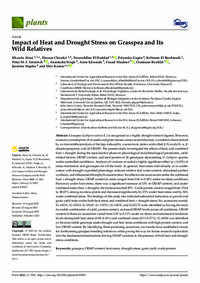Impact of Heat and Drought Stress on Grasspea and Its Wild Relatives

Authors:
Grasspea (Lathyrus sativus L.) is recognized as a highly drought-tolerant legume. However, excessive consumption of its seeds and green tissues causes neurolathyrism, a condition characterized by an irreversible paralysis of the legs induced by a neurotoxin amino acid called β-N-oxalyl-L-α, β- diaminopropionic acid (β-ODAP). The present study investigated the effects of heat, and combined heat + drought during the reproductive phase on physiological and phenological parameters, yield-related factors, ODAP content, and seed protein of 24 genotypes representing 11 Lathyrus species under controlled conditions. Analysis of variance revealed a highly significant effect (p < 0.001) of stress treatments and genotypes for all the traits. In general, heat stress individually or in combination with drought expedited phenology, reduced relative leaf water content, stimulated proline synthesis, and influenced chlorophyll concentration; the effects were more severe under the combined heat + drought stress. ODAP content in seeds ranged from 0.06 to 0.30% under no-stress conditions. However, under heat stress, there was a significant increase of 33% in ODAP content, and under combined stress (heat + drought), the increase reached 83%. Crude protein content ranged from 15.64 to 28.67% among no stress plants and decreased significantly by 23% under heat stress and by 36% under combined stress. The findings of this study also indicated substantial reductions in growth and grain yield traits under both heat stress and combined heat + drought stress. Six accessions namely IG 66026, IG 65018, IG 65687, IG 118511, IG 64931, and IG65273 were identified as having the most favorable combination of yield, protein content, and seed ODAP levels across all conditions. ODAP content in these six accessions varied from 0.07 to 0.11% under no stress and remained at moderate levels during both heat stress (0.09–0.14%) and combined stress (0.11–0.17%). IG 66026 was identified as the most stable genotype under drought and heat stress conditions with high protein content, and low ODAP content. By identifying those promising accessions, our results have established a basis for forthcoming grasspea breeding initiatives while paving the way for future research exploration into the fundamental mechanisms driving ODAP variation in the presence of both heat and drought stress conditions.
